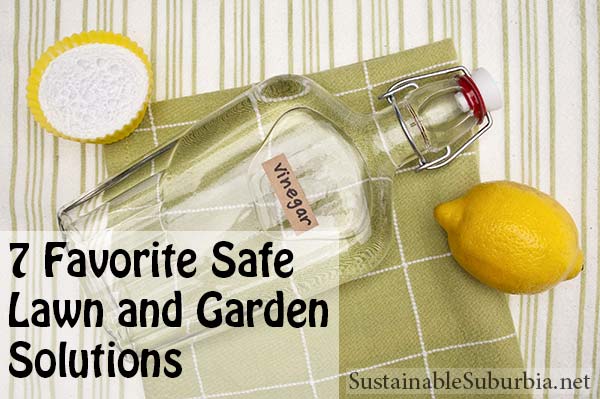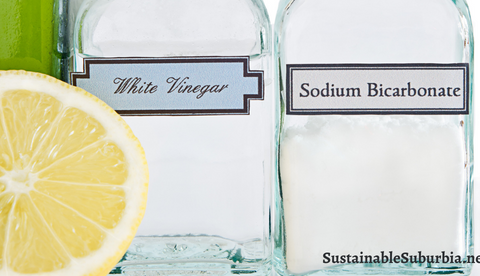A month or two ago, knowing that I would be pushed for time (and internet access) while I am travelling, I put out of a call to my regular readers for guest posts. This week I have a guest post for you from Mary Jo Nieson of www.DelicatePawsLLC.com, sharing her favourite safe garden solutions. Please note that I have not used all of these myself, but I am always interested to learn from the experience of readers who are passionate about supporting our planet.

I was born in the 50’s ,when the post WWII petrochemical surplus world was blossoming. I never caught on to it despite my parents’ wholehearted acceptance. I have been a gardener since my first school garden at the age of 6 when the magic of the sprouted seed showed itself to me! I have been a whole, organic and natural food eater since the 70’s. Well aware even back then of the risks of contaminants in pesticides and herbicides we had to join local farm coops to access these foods. It is fantastic that over time we have driven the market so that even grocery and big box stores now carry organics.
Being a dog owner, lover and now in business serving them I am also concerned about what the dogs’ paws touch as they absorb everything through their feet. I strive to have a ‘green’ environment both in color and intent! This is not so easy in a ‘burb where neighbors all around have their lawns and trees sprayed or spread with pesticides and herbicides.. Of course weeds and bugs can also be troublesome to the environmentally conscious gardener.
Here are 7 of my favorite solutions and how I use them:
1. Corn gluten is just what it says and comes in a granule form. It is used as a weed and feed on the lawn. It should be applied the same time as any weed and feed in the spring when the forsythia bloom. It is nontoxic but of course it may be genetically modified. I am not clear on this or how that might affect my grass and dirt. It does a wonderful job of fertilizing and stops seed from germinating if used at the right time. I only use this on my front yard as I fear my dogs would try to eat it if it were in the back yard.
This website gives a more thorough discussion for those interested.
http://www.safelawns.org/blog/2010/04/corn-gluten-meal-as-weed-control-20-years-later-the-jury-is-still-out/
2. Neem oil is pressed from the seeds of the evergreen family Neem tree in India. It has many natural uses including skin products such as soap and shampoo to heal the skin.. In fact Pop’s Insect-Away shampoo contains neem oil and I use it in my grooming Studio for the dogs. For plants it repels many bugs as well interfering with their feeding cycle and their hormonal systems so it is harder for them to reproduce. I have been using it successfully this year on my heirloom peppers as some natty bug was eating the leaves up. This is good in my book! It is said that neem oil smells like garlic and peanuts. I think it has a smoky garlic like odor. Very recognizable once one has used it.
3. Baking soda: I have found this to be a wonderful deterrent for powdery mildew which for some reason affects my phlox this time of year. To a gallon (4 litres) of water add 1 Tablespoon (3 tsp) each, baking soda, vegetable oil and dish soap. Put in a spray bottle and spray the leaves. I would not use it in bright sunlight, wait for shade so as not to burn leaves. For other garden uses see : http://thegardeningcook.com/baking-soda-in-the-garden/
See http://www.abc.net.au/gardening/stories/s1484689.htm for some more on using bicarb soda and other homemade organic fungacides.
4. Vinegar can be used in the sidewalk and driveway cracks to rid the plants that try to grow and make a life there! It does need to be reapplied after rain and works best in the sun. Sure saves time trying to pry those little suckers out of the cracks and it is inexpensive.
5. Diatomaceous earth is made from the crushed seashells from the bottom of the ocean found in earthy beds and cut into blocks then crushed. It is approximately 3% magnesium, 33% silicon, 19% calcium, 5% sodium, 2% iron, and other trace minerals including titanium, boron, manganese, copper and zirconium. My first experience with it was in a pool filter for an Olympic pool. It can also be used as a filter for clarifying corn and sugar syrups. When purchasing it will be labeled ‘food grade’.
People (and animals) are known to ingest it to rid of internal parasites.
One does not want to get it in the eyes nor inhale it, as it is sharp in a miniscule way unseen by the eye. For this reason it slices and dices all kinds of bugs. I have seen super ant freeways disappear in seconds when this is applied. It is a dust much like talcum powder. I either sprinkle it or use a rose duster. I use it around the foundation of my home both inside and out. I freak out over many legged creepy crawlers and this has stopped them. This natural product is carried back to the nests of ants, roaches, centipedes etc and will take out the queen too. It can be put on carpets and even on your dog’s body and bedding (lightly) to rid the body of fleas. It does not take a lot of product to have an effect, I have used the same small bag for 3 years running.
6. Milky spore: this is a bacterium that kills Japanese beetle grubs and needs to be applied to the lawn 3 times a year for several successive years for success. I have to use something as these beetles find my lawn attractive compared to others chemically treated. At least that’s what I think!
7. Pyola Insect Spray: this is a product that actually kills bugs although is has low toxicity. I have used it with success on my peach trees that suddenly became infested with scale after a bad storm last year. They did reappear this year so I have done several successive sprays according to directions. The ingredients are canola oil with a small percentage of pyrethrin which is from one specific type of chrysanthemum (which is itself called pyrethrum).
Because this will kill any bug on the plant or who eats the sprayed plant I would not use it as an overall garden product. Scale is very resistant and that is why I chose the Pyola. It was the scale or my peaches! This is not safe to use around fish and I would be careful of my pets especially cats going into sprayed areas. Spray at dawn or dusk when the bees aren’t active – pyrethrum is toxic for bees when wet, but fine once it has dried out.
Be sure to be safe by reading and following directions on all products purchased for lawn and garden. Here’s wishing you a green, lush lawn and abundant garden.
Mary Jo Nieson spent 23 years as a Stationary Engineer and as well earned a B.A. in Anthropology. She has a passion for Mother Earth and dogs. She expresses this through dog massage and grooming with organic products in her business, Delicate Paws LLC. She can be found @dogmamajo on Twitter and on her website www.DelicatePawsLLC.com.
Do you have any tips of your own, or any experience with the options Mary Jo uses? Leave a comment and let us know!
Healthy Family | Healthy World


